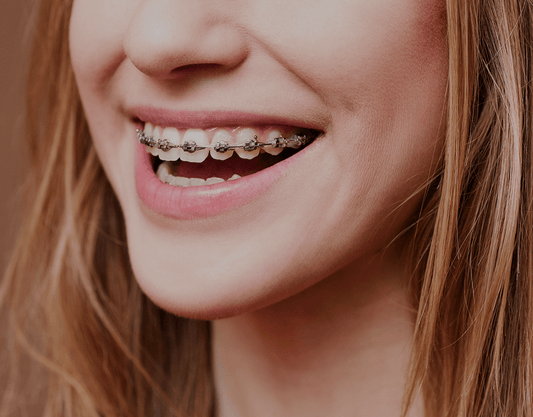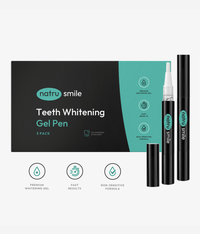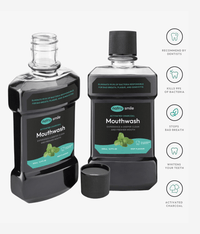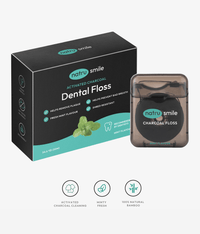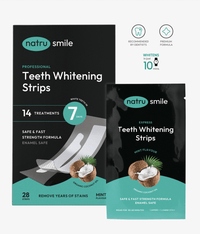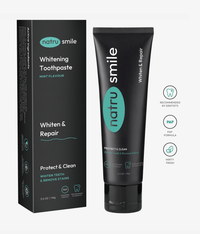
All products are certified by dental expert Dr. Greg Grillo
When you think of braces, you probably picture big smiles with metal brackets, wires, and bands. That’s because metal braces are the most common type of orthodontic treatment today. As a treatment that's been around since the early 1800s, they are also the oldest method of teeth realignment.
But nowadays, they aren't the only method available to new patients. Those who need their teeth realigned have numerous options, including clear aligners and lingual braces.
Still, metal braces are a common choice for many new patients because of their practicality, familiarity, and long-term effectiveness. In this article, we'll give you all the information you need to know about these braces before you get them.
What Are Metal Braces, And How Do They Work?
Metal braces are a type of orthodontic device used to realign, straighten, and improve the appearance of your teeth. They are made up of brackets, bands, wires, and elastic ties that are attached to each tooth and gradually move them into the desired position.
- Brackets: Small metal squares or circles that are glued onto each tooth
- Bands: A thin strip of metal that goes around each individual tooth
- Wires: Thin metal wires that are used to connect the brackets and bands
- Elastic ties: Small rubber bands that secure the wire in place (if needed)
Over time, your orthodontist will adjust these components to gradually move your teeth into alignment. This process can take anywhere from six months to two years or more, depending on your particular orthodontic needs.
Advantages And Disadvantages Of Metal Braces
Like any orthodontic treatment, metal braces have advantages and disadvantages. To help you understand where metal braces excel and where they don't, we've divided our analysis into seven main categories.
1. Efficacy
Metal braces are a tried-and-true method of realigning teeth that have been proven effective over many years. Compared to other types of braces, a recent study showed metal braces to be more effective in treating rotated teeth. The same study also showed that metal braces treatment gave users a longer-term success rate with a lower risk of orthodontic relapse.
2. Dental Health
Cleaning teeth with braces is a challenge that ex-brace-wearers know all too well. There are several issues that may arise from trying to brush, floss, and keep your teeth clean with metal braces:
- Brackets and wiring obstruct the accessibility of your teeth, making it difficult to get to hard-to-reach places
- The wires can trap plaque and food particles between teeth, leading to tooth decay and cavities
- Inadequate cleaning as a result of obstruction can lead to gum disease.
- When brackets cover a significant surface area of teeth, mild discoloration may only impact a small portion of your teeth.
Fortunately, the above issues can be remedied with proper brushing and flossing techniques that take braces into account. There are also special tools available for cleaning around braces, such as interdental brushes and water irrigators.
3. Comfort
Metal braces can feel uncomfortable when first getting them, but over time they should become more comfortable. In the first few weeks of treatment, you may experience some discomfort and irritation as your teeth adjust to their new position. Some people also report feeling pressure when wires and brackets are tightened.
Your orthodontist can take steps to reduce any pain or discomfort that you feel during treatment. This may include using different types of wires or special wax to cover sharp ends on brackets.
4. Variety
When you choose traditional metal braces, you have a few options regarding brace color. This allows you to customize the look of your braces and have fun with the process.
However, it also does not allow for much customization outside of the color. You can choose between gold braces and colored ones, but you cannot opt for smaller brackets, different types of wires, or any other type of bracket design.
5. Duration
Research indicates that braces have a steadier, longer-term success rate compared to other types of orthodontic treatments. This, however, is at the expense of a longer duration of treatment, which typically lasts longer than other types of braces.
That said, the additional amount of time usually amounts to a few months at most—a relatively small price to pay when considering the long-term health benefits of metal braces.
6. Comfortability
Pain during braces treatment is almost guaranteed with metal variations. Common side effects include:
- Mouth sores
- Discomfort when eating or speaking
- Tenderness in the gums and facial muscles from the constant pressure of braces
- Pain on teeth from the force of the wires after tightening sessions
Though these issues may seem uncomfortable, they are usually only temporary and can be managed with painkillers or other medications prescribed by your orthodontist.
7. Appearance
Traditional metal braces are highly visible when you smile and talk. They can bring a lot of attention to your teeth and make it difficult for people to take you seriously if you have an important job or professional role.
Generally, this is not an issue for pre-teens and teenagers (the typical age groups who get braces). But around 25% of those who wear braces are adults, and older age groups may want to consider other treatments for teeth realignment.
How To Care For Metal Braces
Caring for metal braces is straightforward once you've done it a few times. But for first-timers, there are a few steps to take that ensure your metal braces are properly maintained throughout treatment.
- Establish good oral hygiene habits, such as brushing and flossing at least twice daily. This is especially true with metal braces since they can accumulate plaque more easily than other types of orthodontic treatments.
- Schedule regular visits to your orthodontist. That way, they can check on your progress and make adjustments to the braces as needed.
- Be mindful of what you eat. Avoid sticky, hard, or sugary foods that could damage your brackets and wires. If you do consume these types of food, it's important to brush thoroughly afterward.
- Brush your teeth with care. Brushing teeth with braces requires additional attention to detail, as you'll need to make sure all crevices around the brackets are cleaned. Brush gently at a 45-degree angle to clean the wires and pins around your teeth in addition to your regular brushing regimen.
- Wear the rubber bands and any other pieces that your orthodontist prescribes. These are often used to correct misalignments between teeth and can help reduce treatment duration.
- Use an oral irrigator. To remove the excess plaque buildup that can occur with metal braces, it's recommended to use an oral irrigator—a handheld water jet that uses pressurized water to clean teeth and remove bits of food that may be stuck in hard-to-reach places around the braces.
Following these care tips will help ensure you achieve optimal results from your metal braces treatment.
Metal Braces Vs. Ceramic Braces
For those who choose traditional braces with wiring, two options exist: metal and ceramic. Ceramic braces are made of clear or tooth-colored materials, making them less visible than metal braces. This benefit comes with a few caveats, though.
Ceramic braces are less durable than their metal counterparts since the brackets aren't reinforced with the same strength. They generally require closer monitoring and are up to twice as likely to break or chip during treatment.
Because of their lack of reinforcement, they may take slightly longer to realign teeth than metal braces.
Ceramic braces can also discolor over time without proper care. This can be avoided with many of the same care tips listed in this article, but with extra attention to ensure the brackets stay clear.
Metal Braces Vs. Invisalign
Invisalign is the best way to straighten teeth without braces—its clear trays are virtually invisible, making them a popular choice for adults and teens alike.
Invisalign offers near-invisible aligners that are lightweight, comfortable, and easy to keep clean. Since they are removable, they don't cause irritation or speech impediments like traditional braces do. This makes whitening an option, while teeth whitening with braces is impossible.
Invisalign is also within the same price range as metal braces, with treatments costing between $3,000 and $5,000 on average.
According to a recent study, clear braces also showed an advantage in speed of treatment over metal braces, saving patients several months in treatment time.
Over the course of ten years, however, Invisalign patients showed significantly higher rates of orthodontic relapse than those treated with traditional braces.
The same study also pointed to braces as the clear winner for severe misalignment problems like rotation, tipping, and angulation.
Metal Braces Vs. Lingual Braces
Lingual braces are just like traditional braces, except they are applied to the back of your teeth—making them virtually invisible from the front.
This treatment is more expensive than metal braces and can take longer to complete, but it offers superior results for those who want a discreet orthodontic solution.
Due to their placement, lingual braces require more specialized cleaning and care to prevent damage and discoloration of the brackets. It's recommended to avoid eating hard or crunchy foods that may cause the wires and brackets to break, as well as sugary snacks that promote plaque buildup around the brackets.
Aside from the additional dental work and cost, lingual braces don't require visible brackets (metal braces) or shiny plastic trays (Invisalign) to get the job done.
In addition to aesthetic benefits, lingual braces also eliminate the need to get rid of yellow teeth with braces.
Metal Braces Vs. Self-Ligating Braces
Metal braces and self-ligating braces are similar. The only difference is that self-ligating braces don't require elastic ties to hold the wire in place.
This can lead to shorter treatment times since the pressure of the wire is more consistent over time. Self-ligating braces are also known for being easier to keep clean, as there's one fewer thing (elastic bands) to worry about brushing or trapping food.
Overall, self-ligating braces are a great option for those seeking faster treatment times and less hassle during the cleaning process.
Clear Braces Vs. Metal Braces
The issues ceramic braces cause are similar to the issues with clear braces, as are the benefits.
Clear braces use the same mechanisms as metal braces, so treatment times and cleaning are generally comparable. However, clear braces are made from clear materials that blend in more easily than metal—making them almost unnoticeable in some cases.
For those who don't want their teeth to be visible during treatment, clear braces may be the better choice. That said, their durability is slightly lower than metal braces, so they may not be the right choice for those with more serious misalignment issues.
Cost Of Metal Braces
Although the cost of braces has started to equalize with advancements in technology and increased accessibility to a wider range of treatments, metal braces are still considered the least expensive option.
The exact cost of treatment depends on several factors, including the type of braces you choose, your location and orthodontist’s fees, and how long the braces need to be worn.
While costs may vary widely among different providers, metal braces typically come in at an average cost of $3,000 to $6,000, according to ValuePenguin data.
Are Metal Braces Worth It?
Braces cost a lot of money and require a significant amount of time to show results. For adults, they also limit the potential to pursue a professional career during treatment.
However, metal braces offer a great deal of benefits that make them worth it in the long run. They tend to be one of the most affordable orthodontic treatments, and they are known for providing excellent long-term results. Their durability also means they can often handle more serious misalignment issues than alternatives like Invisalign or clear braces.
Once patients get their braces taken off, nearly everyone agrees the time, money, and effort put into metal braces is worth it—especially when you see a beautiful, straight smile as the result.
Want to learn more? These are the questions our customers ask us most.
How Many Years Do You Need For Metal Braces?
he required amount of time for metal braces depends on numerous factors, including the severity of the misalignment and how often the patient visits their orthodontist for adjustments. Generally speaking, metal braces can take anywhere from six months (on the low end) to over two years for complete realignment.
Do Metal Braces Change Your Face?
Braces can change your jawline, chin, and shape of your mouth, which can significantly impact your facial profile. You can use metal braces to push the jaw forward to provide a more symmetrical alignment of the teeth, resulting in a slightly different facial profile. However, this is usually seen as an improvement after treatment.
What Are The Side Effects Of Metal Braces?
Although metal braces are effective, they have a long list of side effects, including:
- Mouth sores caused by rubbing against the brackets or wires.
- Increased saliva levels due to having something foreign in your mouth.
- Pain, discomfort and irritation in the mouth, especially during eating.
- Difficulty speaking clearly for a few days after braces are first placed.
- Increased risk of tooth decay due to difficulty brushing and flossing around braces.
- Gum disease because food can get stuck under orthodontic appliances.
- Temporarily discolored teeth due to increased plaque accumulation around appliances.
How Painful Are Metal Braces?
The level of pain you will experience is unique to you and your tolerance for pain, but in general, most people report that metal braces are more uncomfortable than other orthodontic treatments. The initial installation of braces can be the most painful part of the process, as your teeth need time to adjust to the pressure and presence of a foreign object.
How Long Do Metal Braces Hurt?
Metal braces can cause initial pain and discomfort for a few days after they are first placed. During this period, it is normal to experience some soreness in the mouth and teeth while the mouth adjusts to the new appliance. After a few days, most people find the discomfort from metal braces decreases and any residual soreness is mild and manageable.
Do Metal Braces Work Faster?
No, metal braces do not work faster than other types of braces. While the duration of treatment with metal braces will vary depending on the individual's circumstances, metal braces usually take a little bit longer than clear aligners.
Do Metal Braces Take Longer?
Metal braces take slightly longer in some instances, although this can vary depending on the individual's situation and how frequently they visit their orthodontist for adjustments. In general, metal braces take slightly longer than clear aligners like Invisalign but are still an effective way to realign teeth and jaws.
Do Metal Braces Damage Teeth?
When utilized properly and maintained regularly by an orthodontist, metal braces should not cause permanent damage to teeth. However, they can deteriorate oral health without proper care and upkeep, increasing the risk of tooth decay and gum disease.
Are Metal Braces Toxic?
Metal retainers can contain heavy metals including nickel and chromium—both of which have been linked to allergic reactions and toxicity. However, these metals are only present in trace amounts and are unlikely to cause any significant health issues.
Are Metal Braces Cheaper?
The total cost of different orthodontic care options is beginning to equalize. Still, metal braces are usually the cheapest option for realigning teeth and correcting bite issues. Since cost is a case-by-case determination, we recommend getting multiple quotes and weighing your options before committing to one treatment.
Can Metal Braces Cause Stomach Problems?
Metal braces themselves can't cause stomach issues. But they may cause you to change your diet, which could result in an upset stomach. If you are used to eating harder foods like apples or carrots and then have to switch to softer, more processed alternatives, it could cause digestive issues.
Can Metal Braces Cause Sore Throat?
During visits to your orthodontist, braces expose you to metals, latex, dental-grade composite materials, and bacteria that can irritate your throat. This could result in an itchy or sore throat, which is usually temporary.
Can Metal Braces Cause Seizures?
For patients with epilepsy, additional safety measures may need to be taken for orthodontic care. However, braces' ability to cause seizures is neither well-documented or well-researched, making it a rare and unlikely cause of seizures.
Can Metal Braces Stain Your Teeth?
Your risk of staining with metal braces is higher than with clear aligners, as the brackets and wires can collect food particles and cause staining. To reduce your risk of staining, make sure to brush your teeth at least twice a day, floss daily, and use an antimicrobial mouthwash at least once per day. Additionally, take extra care when eating foods that are known to cause staining.
Can Metal Braces Be Removed For Special Occasions?
Once your braces are fitted, they are stuck to your teeth until your orthodontist removes them. In some cases, they may be able to adjust the wire or remove ties to allow you to attend special events without braces. However, this should only happen after consulting with your orthodontist and following their instructions closely.
Can Metal Braces Cause Acne?
Braces contain metals, chemicals, and other materials that can cause irritation around your mouth. The stress put on your body caused by braces may increase oil production as well, which can lead to increased acne outbreaks.
Still, the relationship between braces and acne is only based on anecdotal assumptions and not backed by scientific evidence or proof.
How Are Metal Braces Put On?
When you visit your orthodontist to apply your braces, you can expect to follow the process below:
- Clean and prepare the teeth: The orthodontist will clean and prepare the teeth by removing any plaque or tartar buildup before applying metal braces.
- Apply an adhesive: An adhesive is used to attach brackets to each tooth, which provides a surface for bonding the archwire.
- Place brackets on teeth: After the adhesive has been applied, the brackets are placed onto each tooth, one after another, until all of them have been secured in place.
- Put bands around back molars: To provide additional stability, bands may be placed around the back molars and other teeth that need extra support during treatment.
- Connect archwires with elastic ties: Once all brackets have been put into place, elastic ties are then connected between them and tightened using special pliers, so they remain secure throughout care.
- Attach hooks for elastics (if applicable): Small hooks can also be added to certain brackets if needed for elastics (rubber bands) to be attached later in the process.

